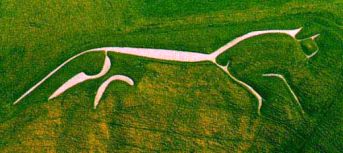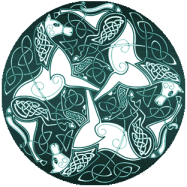Epona is the name of the ancient horse goddess of the
pagan Gallic peoples and whose name and worship spread throughout the
Celtic and Roman worlds. Today she is still honoured and revered by
those who follow the old religion, such as myself, and I've tried in these
pages to put down some of my thoughts and studies on Epona, her history
and her present.
Obviously this has a very personal bias and not everyone is going to agree
with me on everything but all comments are welcome and I hope you find
this informative and entertaining.
The Historical Epona
 Epona can be traced back under that name to
the Gallic peoples of what is now northern France. However as these
people, along with the Celts, are decendants of tribal peoples who came
from the east, spreading up along the Danube vallet into central and
western Europe, it is not surprising that kindred peoples have the horse
as a primary totem deity as the horse would have been vital for a
wandering people. These peoples, as Pagans today tend to do,
associate the male energies of nature with horned animals, such as the
stag. It seemed natural then then that the mare became associated
with the feminine aspects of nurturing and fertility. Early carvings
of Epona often show her with foals or feeding horses emphasising this
aspect. In particular white mares were venerated - most likely
because white was always seen as a "pure" colour with deep
spiritual connotations and also, unless specifically bred for, white
horses are uncommon.
Epona can be traced back under that name to
the Gallic peoples of what is now northern France. However as these
people, along with the Celts, are decendants of tribal peoples who came
from the east, spreading up along the Danube vallet into central and
western Europe, it is not surprising that kindred peoples have the horse
as a primary totem deity as the horse would have been vital for a
wandering people. These peoples, as Pagans today tend to do,
associate the male energies of nature with horned animals, such as the
stag. It seemed natural then then that the mare became associated
with the feminine aspects of nurturing and fertility. Early carvings
of Epona often show her with foals or feeding horses emphasising this
aspect. In particular white mares were venerated - most likely
because white was always seen as a "pure" colour with deep
spiritual connotations and also, unless specifically bred for, white
horses are uncommon.
The worship of the horse had certainly spread to Britain by the Bronze
Age. The most famous of all horse monuments, the White Horse of
Uffington, has been dated to around 1400 BCE. This hill figure,
carved deep into solid chalk on a Berkshire hillside, depicts a stylised
horse combining elements of bird and dragon into her running form.
Many claims have been made for the provenance of this hill figure,
particularly those claiming to link it to Alfred the Great's defeat of the
Danes and also to the semi-mythical Jutish princes Hengist and Horsa
("Stallion" and "Mare")  however OSL dating places the
original figure as having been in existance for at least 3000 years.
The nearby neolithic chambered long barrow of Wayland's Smithy (named
after the Norse hero, Weyland, who can also be seen as an aspect of Odin)
also points to the site being of a great age and, as Odin was the focus of
a horse cult, it is possible that horse worship has been occurring on this
site since neolithic times. The Uffington horse is quite clearly
female (as are all the truly old white horses in England) and there is
mention of the Uffington mare having had a foal beside her in Ralf De
Deceto's "Tract of Wonders" dated 1180; however no evidence of a
foal has ever been found and no subsequent mentions are made in any texts.
however OSL dating places the
original figure as having been in existance for at least 3000 years.
The nearby neolithic chambered long barrow of Wayland's Smithy (named
after the Norse hero, Weyland, who can also be seen as an aspect of Odin)
also points to the site being of a great age and, as Odin was the focus of
a horse cult, it is possible that horse worship has been occurring on this
site since neolithic times. The Uffington horse is quite clearly
female (as are all the truly old white horses in England) and there is
mention of the Uffington mare having had a foal beside her in Ralf De
Deceto's "Tract of Wonders" dated 1180; however no evidence of a
foal has ever been found and no subsequent mentions are made in any texts.
Epona existed in other guises throughout the Celtic world, becoming Rhiannon in Wales and Macha in Ireland. In all the legends attached to these two deities they are portrayed with heroic qualities, prepared to sacrifice themselves, a characteristic of the ancient worship of the horse goddess aptly demonstrated in the Irish kingship ritual and repaid in acts such as that of Versingetorix who at his last stand against the Roman army, rather than risk the slaughter of his horses, sent them behind the lines and faced his enemies on foot.
Despite the loss of the Gallic kings to the Roman invasion Epona's worship flourished as she was adopted by the cavalry legions and spread throughout the empire. There is evidence, from writings such as "The Golden Ass" of Apuleus, that she spread further from just being a goddess of the cavalry into being a goddess of anyone who worked or had dealings with horses.
The Decline and Rebirth of Epona
 With the decline of the Roman empire and the
spread of Christianity throughout Europe the worship of Epona both
declined under the dead hand of the bishops and princes but was also
absorbed and transformed within the imported religion. The symbol of
the white horse was absorbed into Christian iconography as one of purity,
many saints being depicted on white horses. However direct worship
of the divine in animal form was strongly supressed but clung on in the
form of the "obby oss" dances in their varoius guises and the
hill figures of old were deemed still worthy of maintaining and regular
"ritual" scouring and cleaning of the horses, accompanied by
games and revelry, continued to take place throught the centuries.
With the decline of the Roman empire and the
spread of Christianity throughout Europe the worship of Epona both
declined under the dead hand of the bishops and princes but was also
absorbed and transformed within the imported religion. The symbol of
the white horse was absorbed into Christian iconography as one of purity,
many saints being depicted on white horses. However direct worship
of the divine in animal form was strongly supressed but clung on in the
form of the "obby oss" dances in their varoius guises and the
hill figures of old were deemed still worthy of maintaining and regular
"ritual" scouring and cleaning of the horses, accompanied by
games and revelry, continued to take place throught the centuries.
It was with the rebirth of interest in the old religion around the turn of the century and with the reinvention of The Craft following the publication of Gardiner's "High Magic's Aid", the repeal of the Witchcraft laws and the movement towards reincorporating the female into the divine that Epona could truly begin to emerge from the shadows. Although changed somewhat through the years of exile (as have all the old Gods and Goddesses) she has once more taken her rightful place in our imaginations and workings. There are now a number of websites that feature Epona and associated horse imagery (I've listed some of the ones I like on the links page)
Redvane Fox